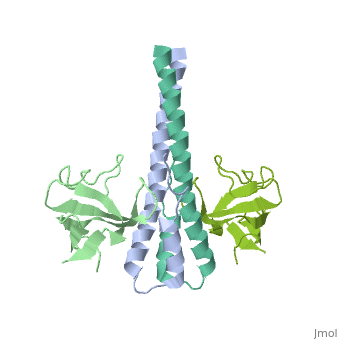2hkq: Difference between revisions
No edit summary |
No edit summary |
||
| Line 7: | Line 7: | ||
|ACTIVITY= | |ACTIVITY= | ||
|GENE= MAPRE1 ([http://www.ncbi.nlm.nih.gov/Taxonomy/Browser/wwwtax.cgi?mode=Info&srchmode=5&id=9606 Homo sapiens]), DCTN1 ([http://www.ncbi.nlm.nih.gov/Taxonomy/Browser/wwwtax.cgi?mode=Info&srchmode=5&id=9606 Homo sapiens]) | |GENE= MAPRE1 ([http://www.ncbi.nlm.nih.gov/Taxonomy/Browser/wwwtax.cgi?mode=Info&srchmode=5&id=9606 Homo sapiens]), DCTN1 ([http://www.ncbi.nlm.nih.gov/Taxonomy/Browser/wwwtax.cgi?mode=Info&srchmode=5&id=9606 Homo sapiens]) | ||
|DOMAIN= | |||
|RELATEDENTRY=[[1txq|1TXQ]], [[2hkn|2HKN]], [[2hl3|2HL3]], [[2hl5|2HL5]] | |||
|RESOURCES=<span class='plainlinks'>[http://oca.weizmann.ac.il/oca-docs/fgij/fg.htm?mol=2hkq FirstGlance], [http://oca.weizmann.ac.il/oca-bin/ocaids?id=2hkq OCA], [http://www.ebi.ac.uk/pdbsum/2hkq PDBsum], [http://www.rcsb.org/pdb/explore.do?structureId=2hkq RCSB]</span> | |||
}} | }} | ||
| Line 16: | Line 19: | ||
==Disease== | ==Disease== | ||
Known | Known disease associated with this structure: Neuropathy, distal hereditary motor, type VIIB OMIM:[[http://www.ncbi.nlm.nih.gov/entrez/dispomim.cgi?id=601143 601143]], Amyotrophic lateral sclerosis, susceptibility to OMIM:[[http://www.ncbi.nlm.nih.gov/entrez/dispomim.cgi?id=601143 601143]] | ||
==About this Structure== | ==About this Structure== | ||
| Line 36: | Line 39: | ||
[[Category: p150glued]] | [[Category: p150glued]] | ||
''Page seeded by [http://oca.weizmann.ac.il/oca OCA ] on | ''Page seeded by [http://oca.weizmann.ac.il/oca OCA ] on Mon Mar 31 03:31:45 2008'' | ||
Revision as of 03:31, 31 March 2008
| |||||||
| , resolution 1.86Å | |||||||
|---|---|---|---|---|---|---|---|
| Gene: | MAPRE1 (Homo sapiens), DCTN1 (Homo sapiens) | ||||||
| Related: | 1TXQ, 2HKN, 2HL3, 2HL5
| ||||||
| Resources: | FirstGlance, OCA, PDBsum, RCSB | ||||||
| Coordinates: | save as pdb, mmCIF, xml | ||||||
Crystal structure of the C-terminal domain of human EB1 in complex with the CAP-Gly domain of human Dynactin-1 (p150-Glued)
OverviewOverview
Dynamic microtubule plus-end tracking protein (+TIP) networks are implicated in all functions of microtubules, but the molecular determinants of their interactions are largely unknown. Here, we have explored key binding modes of +TIPs by analyzing the interactions between selected CAP-Gly, EB-like, and carboxy-terminal EEY/F-COO(-) sequence motifs. X-ray crystallography and biophysical binding studies demonstrate that the beta2-beta3 loop of CAP-Gly domains determines EB-like motif binding specificity. They further show how CAP-Gly domains serve as recognition domains for EEY/F-COO(-) motifs, which represent characteristic and functionally important sequence elements in EB, CLIP-170, and alpha-tubulin. Our findings provide a molecular basis for understanding the modular interaction modes between alpha-tubulin, CLIPs, EB proteins, and the dynactin-dynein motor complex and suggest that multiple low-affinity binding sites in different combinations control dynamic +TIP networks at microtubule ends. They further offer insights into the structural consequences of genetic CAP-Gly domain defects found in severe human disorders.
DiseaseDisease
Known disease associated with this structure: Neuropathy, distal hereditary motor, type VIIB OMIM:[601143], Amyotrophic lateral sclerosis, susceptibility to OMIM:[601143]
About this StructureAbout this Structure
2HKQ is a Protein complex structure of sequences from Homo sapiens. Full crystallographic information is available from OCA.
ReferenceReference
Key interaction modes of dynamic +TIP networks., Honnappa S, Okhrimenko O, Jaussi R, Jawhari H, Jelesarov I, Winkler FK, Steinmetz MO, Mol Cell. 2006 Sep 1;23(5):663-71. PMID:16949363
Page seeded by OCA on Mon Mar 31 03:31:45 2008
